
The Caridea, commonly known as caridean shrimp or true shrimp, are an infraorder of shrimp within the order Decapoda. This infraorder contains all species of true shrimp. They are found widely around the world in both fresh and salt water. Many other animals with similar names – such as the mud shrimp of Axiidea and the boxer shrimp of Stenopodidea – are not true shrimp, but many have evolved features similar to true shrimp.
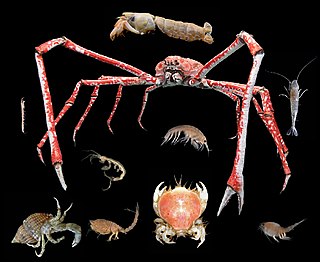
Malacostraca is the largest of the six classes of crustaceans, containing about 40,000 living species, divided among 16 orders. Its members, the malacostracans, display a great diversity of body forms and include crabs, lobsters, crayfish, shrimp, krill, prawns, woodlice, amphipods, mantis shrimp, tongue-eating lice and many other less familiar animals. They are abundant in all marine environments and have colonised freshwater and terrestrial habitats. They are segmented animals, united by a common body plan comprising 20 body segments, and divided into a head, thorax, and abdomen.

Astacidea is an infraorder of decapod crustaceans including lobsters, crayfish, and their close relatives.
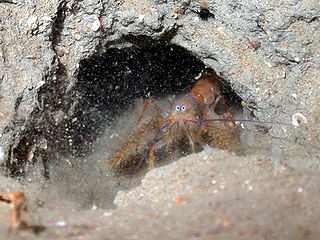
Furry lobsters are small decapod crustaceans, closely related to the slipper lobsters and spiny lobsters. The antennae are not as enlarged as in spiny and slipper lobsters, and the body is covered in short hairs, hence the name furry lobster. Although previously considered a family in their own right, the furry lobsters were subsumed into the family Palinuridae in 1990,. Subsequent molecular phylogenetics studies have confirmed that the furry lobsters genera don't form a natural group and were both nested among the spiny lobster genera in family Palinuridae. The family now includes the two furry lobster genera and ten spiny lobster genera.

Leptostraca is an order of small, marine crustaceans. Its members, including the well-studied Nebalia, occur throughout the world's oceans and are usually considered to be filter-feeders. It is the only extant order in the subclass Phyllocarida. They are believed to represent the most primitive members of their class, the Malacostraca, and first appear in the fossil record during the Cambrian period.

Eucarida is a superorder of the Malacostraca, a class of the crustacean subphylum, comprising the decapods, krill, Amphionides and Angustidontida. They are characterised by having the carapace fused to all thoracic segments, and by the possession of stalked eyes.
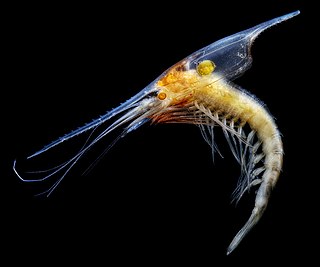
Lophogastrida is an order of malacostracan crustaceans in the superorder Peracarida, comprising shrimp-like animals that mostly inhabit the relatively deep pelagic waters of the oceans throughout the world.

Homoloidea is a superfamily of dromiacean crabs. Homoloidea belongs the group Dromiacea, taxonomically ranked as a section, and is the sister group to Dromioidea. Dromiacea is the most basal grouping of Brachyura crabs, and likely diverged from the rest of Brachyura around the Late Triassic or Early Jurassic. The close relation between Homoloidea and Dromioidea is primarily established through ultrastructural characteristics of the sperm.

Hippoidea is a superfamily of decapod crustaceans known as sand crabs or mole crabs.
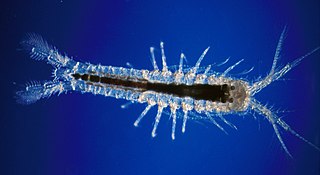
Mictacea is a monotypic order of crustaceans. It was originally erected for three species of small shrimp-like animals of the deep sea and anchialine caves. They were placed in two families, the Mictocarididae and Hirsutiidae, but Hirsutiidae is now placed in order Bochusacea, leaving Mictacea with a single species, Mictocaris halope.

Ascothoracida is a small group of crustaceans, comprising around 100 species. They are found throughout the world, and are parasites on cnidarians and echinoderms.
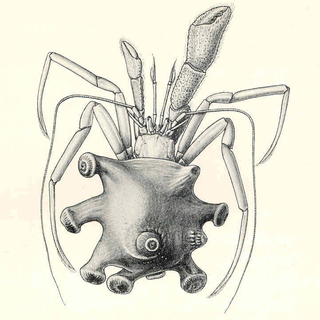
The Parapaguridae are a family of marine hermit crabs from deep waters. Instead of carrying empty gastropod shells like other hermit crabs, they carry colonies of dozen or more sea anemones or zoanthids. Some genera, such as Bivalvopagurus and Tylaspis, do not inhabit shells. The following genera are included:

Cheiragonidae is a small family of crabs, sometimes called helmet crabs, placed in its own superfamily, Cheriagonoidea. It comprises three extant species, Erimacrus isenbeckii, Telmessus acutidens and Telmessus cheiragonus, there are no yet evidences of Cheiragonidae in the fossil record. Many of these crabs were formerly treated as members of the Atelecyclidae.

Bresilioidea is a superfamily of shrimp. It is likely to be an artificial group, containing five families which may or may not be related.

The Mysidacea is a group of shrimp-like crustaceans in the superorder Peracarida, comprising the two extant orders Mysida and Lophogastrida and the prehistoric Pygocephalomorpha. Current data indicate that despite their external similarities, the three orders are not closely related, and the taxon Mysidacea is not used in modern taxonomy.
The Calabozoidea or Calabozoida are a suborder of freshwater isopod crustaceans.

Stenopodidae is a family of decapods in the order Decapoda. There are about 6 genera and more than 30 described species in Stenopodidae.

Martin David Burkenroad was an American marine biologist. He specialized in decapod crustaceans and fisheries science.

Crustaceans form a large, diverse arthropod taxon which includes such animals as decapods, seed shrimp, branchiopods, fish lice, krill, remipedes, isopods, barnacles, copepods, amphipods and mantis shrimp. The crustacean group can be treated as a subphylum under the clade Mandibulata. It is now well accepted that the hexapods emerged deep in the Crustacean group, with the completed group referred to as Pancrustacea. Some crustaceans are more closely related to insects and the other hexapods than they are to certain other crustaceans.
The Limnoriidea are a suborder of marine isopod crustaceans.

















